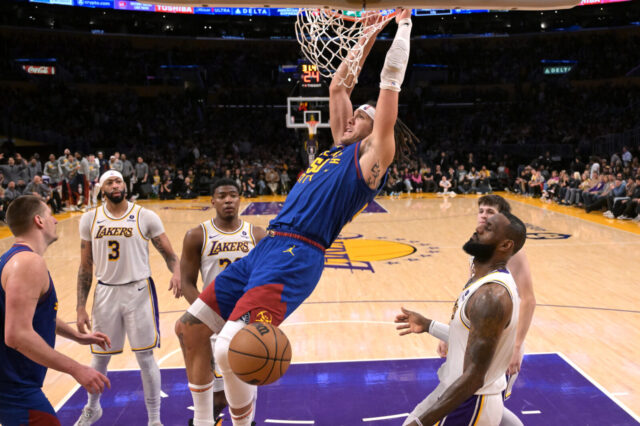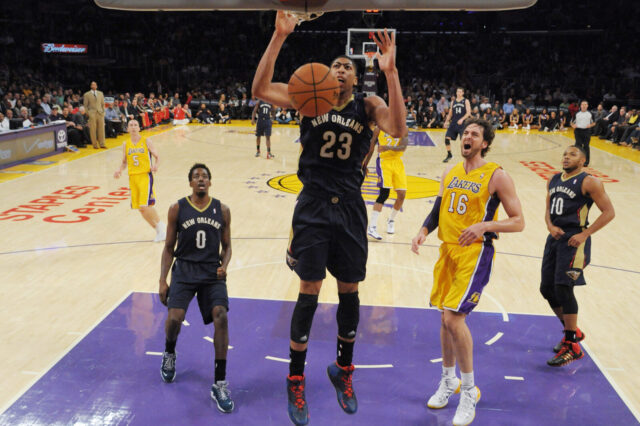The best and most versatile offenses win championships in the current NBA climate.
The Toronto Raptors, in need of larger variety from their pick and roll guard centric units with Kyle Lowry and DeMar DeRozan, found just what they needed in a major front court upgrade last year. Kawhi Leonard is the obvious piece, but in the end, Pascal Siakam and Marc Gasol were the difference makers offensively. Siakam added an additional ball handling and finishing element to the starting lineup while Gasol added playmaking and floor spacing from the top of the key. The two players added enough variety to Toronto’s roster to relieve Lowry and Leonard from their roles as the sole creators in the starting five, and combined with defensive versatility and excellence, they won a championship.
The Golden State Warriors have operated in a similar fashion for years. Noted for their heavy motion offense off-ball with Stephen Curry and Klay Thompson running off screens, Draymond Green acts as the point forward in many sets. Then, Kevin Durant became an additional playmaker with the ball in his hands out of the pick and roll and as an isolation scorer. When both Durant and Thompson went down with injuries, Curry became the de facto lead ball handler and ran pick and rolls with Green to high success. The Warriors proved to be a versatile offense with their talented pieces, and it allowed them to weather the storm against many teams the last several years.
For the Denver Nuggets, they achieved offensive nirvana only once in the last several years: after December 15th, 2016 in the 2016-17 regular season. This marked the day Denver decided to start Nikola Jokic as the primary big for the remainder of the season and beyond. Even with Emmanuel Mudiay and Jameer Nelson splitting time at point guard, the Nuggets achieved an Offensive Rating of 115.0 points per 100 possessions post-December 15th, best in the NBA during that stretch and higher than the Warriors and Houston Rockets during that stretch.
How did they achieve it? Floor spacing at forward and a point guard that set up Nikola Jokic to be the primary playmaker.
The 2016-17 offense was truly beautiful to watch. The joy of this offense stemmed from the involvement of every player on the floor. Jokic would distribute scoring opportunities to every starter, including Nelson, Gary Harris, Danilo Gallinari, and either Wilson Chandler or Kenneth Faried. The Serbian big man wasn’t a superstar at that moment, but he was a superstar playmaker in his lesser minutes. Adjusting for minutes played, Jokic was creating as many points with his assists as both Draymond Green and Stephen Curry.
Since that brief stretch, the Nuggets have lost some of the luster on their high powered offense. Jokic’s individual scoring efficiency has gone down (64.0 True Shooting % in 2016-17 —> 60.3 in 17-18 —> 58.9 in 18-19) and so has the team’s offensive rating, even though Jokic is creating more opportunities for others. That 115.0 Offensive Rating in 2016-17 dropped to 111.4 in 17-18 and 112.1 in 18-19. In last week’s mailbag, I discussed how Gary Harris’ changing offensive role was a major pivot point for deciding how Denver should best run their offense. This also coincided with the loss of Danilo Gallinari at forward, one of the best floor spacing forwards in the NBA.
But both of those changes are moot if Jamal Murray improves as a playmaker. That will convert Denver’s offense to one of the top units in the NBA.
This content is no longer available.
Among the top four offenses (Offensive Rating > 113.0) are distinct superstar guards and a balanced Milwaukee Bucks unit centered around Giannis Antetokounmpo. The Golden State Warriors with Stephen Curry and Klay Thompson, the Houston Rockets with James Harden and Chris Paul (how Russell Westbrook affects this will be fascinating), and the Portland Trail Blazers with Damian Lillard and CJ McCollum all have fantastic guard duos with differing traits offensively.
The Nuggets don’t have that, but they have Nikola Jokic, who operates the Nuggets offense much in the same way that the Antetokounmpo operates the Bucks offense — an interior big with playmaking responsibilities. They do it in different ways, but the floor structure is almost exactly the same. Murray isn’t exactly like Eric Bledsoe or Khris Middleton as a secondary ball handler, but he shares similar traits there too. Watch Bledsoe run the two-man game with Giannis in a similar fashion to Murray and Jokic.
The main difference in the two teams is the utilization of role players and how they operate around the primary offense the team runs in the half court. The Bucks are heavily invested in maximizing Giannis, and they did so by finishing in the Top 2 among two play types last year: spot ups and transition.
The floor is perfectly spaced on this play with the driver down the right side, the rolling big at the front of the rim, a guard in the corner and two forwards in the slots. This works because the Bucks could trust Bledsoe, their secondary playmaker, to run a set designed for options other than Giannis. It diversified their offense and helped the role players get involved without relying on their best player. Giannis was the MVP last season and deservedly so, but he wasn’t the only playmaker on the Bucks by design, which helped everyone get better.
The Nuggets need a similar environment around Jokic, and it starts with the playmaking improvements of Murray. Particularly his diversification of passes made. While most passers have their favorite recipients, Murray loves to pass to Jokic and struggles to make reads beyond the first passing option.
This content is no longer available.
During the regular season, Murray was better about varying his passing looks and finding the open man, though it certainly helped that for some time, his minutes were staggered with the bench unit so he could make plays for Monte Morris, Malik Beasley, and especially Mason Plumlee.
However, as the playoffs put on full display, the Nuggets had trouble creating offense unless it was Murray passing to Jokic or Jokic distributing to everyone. There were very few opportunities outside of transition where Nuggets players passed to each other for shots that didn’t include Jokic. Here’s an example of an offensive set that would accomplish just that: an elevator doors look out of a sideline inbounds play.
But this was a designed look. One where Murray’s read was relatively simple and his assignment to draw the eyes of the defense while Harris slid through the elevator that was Millsap and Jokic. More important is the opportunity to see the floor and improvise passes on a consistent basis based on the look a defense may offer. This kick out to Harris was extremely impressive and the exact look Murray should seek out more frequently.
That showcases quite clearly the growth of Murray as a playmaker. He has the capability to see these passes and is developing the skill and touch to execute them consistently. Being a point guard is hard, but Murray is learning quite well on the fly, and how quickly he figures out the next steps as a playmaker will determine Denver’s future levels offensively.
This is why, in order to become a top tier offense, the Nuggets must realize their potential to become a blend of the guard driven Warriors/Rockets/Blazers and the Giannis-centric Bucks. And the three primary steps to do so are as follows:
- Murray takes step towards being an elite playmaker
- Denver develops three ball handling options at guard and wing
- Denver increases the spacing around Jokic
The discussion around Murray’s improvement is important, but so is the ability of Denver’s other wing starters (Gary Harris and Will Barton) to handle the ball next to him. The beginning of 2018-19 saw Harris made some incredible plays with the ball in his hands, and getting him back to that level would completely diversify Denver’s offense.
The same goes for Barton, who saw a major decrease in his efficiency (TS%) and playmaking (AST%) this season while spending most of the year recovering from a hip injury. If Barton can return to the level he displayed athletically in 2017-18, the rest of his game should follow suit. He shot the ball well, finished at the rim, and showcased creative passing when prompted.
It’s important that all three of Murray, Harris, and Barton are capable shooters as well. In 2017-18, the lowest three-point % among them was Barton’s 37.0% truly highlighting the spacing potential of the guard trio. The Milwaukee Bucks have been able to space the floor around Giannis with Middleton, Brogdon, and Brook Lopez surrounding the Bledsoe-Giannis pick and roll. For Denver to truly get to where they need to be offensively, there must be more spacing at all auxiliary positions, including power forward.
Millsap shot the ball well from the perimeter last year at 36.5% on 2.3 attempts per game, but so much of floor spacing is having a high number of attempts and to be consistently threatening to the defense. For all of the great traits Millsap brings to the court defensively and as a high IQ offensive player, teams don’t see him as a shooting risk. Denver having a guy on the court that can both operate the short corner and shoot around the perimeter would be massively helpful in spacing the floor for various sets with Denver’s ball handlers. Jerami Grant satisfies at least one of those qualities with his short corner athleticism. We will see how real his jumper is very shortly.
Jokic is talented enough to be the primary engine behind an elite offense, but in order for Denver to return to that possibility as soon as 2019-20, certain adjustments and/or developments must occur. The Denver roster is talented enough to produce a top offense tomorrow, but the teams above them have formulated an identity where the star players do what they do best while the role players stay attached to the scoring areas that make them the most valuable. Over 66% of PJ Tucker’s total shots were corner threes and layups in 2018-19. 65% of Brook Lopez’s shots came from three as well.
Finding unique ways to structure the shot distribution for role players is the new meta to generate the most efficient offense possible. It isn’t enough to just have superstar talent anymore, or else the Oklahoma City Thunder would have better than the 16th best offense in the NBA last year. Superstar talent only works if the offense around them maximizes the talent in the most efficient ways.
This content is no longer available.
For Denver to reach that level, they may have to operate in a less traditional mold offensively. The Jokic-Murray pick and roll with Murray as the screener was extremely efficient. Why not use the same sets with Harris? Or even Barton or Craig? Jerami Grant setting screens for Jokic and then causing a switch would be impossible to deal with for most teams. Moving Millsap (and by extension his defender) into the corner or short corner more frequently may generate better spacing for the rest of the offense. Letting Murray and Harris run off screens with opportunities for back cuts by the screeners with Jokic quarterbacking at the top of the key seems like a great way to diversify the looks Denver can offer.
Either way, there are steps Denver can take to becoming an elite offense again, and that seems like the best way to win a championship in today’s NBA. The last year an NBA champion did NOT have a Top Five offense was the 2011-12 Miami Heat eight years ago. They ranked sixth in offensive rating and also had the fourth best defensive rating. Offense has become the key to the highest levels of NBA success, and while being capable defensively is also important, offense is why Denver lost in the playoffs last year. The Blazers were a better offensive team and outscored Denver with smaller lineups.
The Nuggets have the capacity to be an elite offense. It’s time to see whether they can perform the steps necessary to take that leap.


